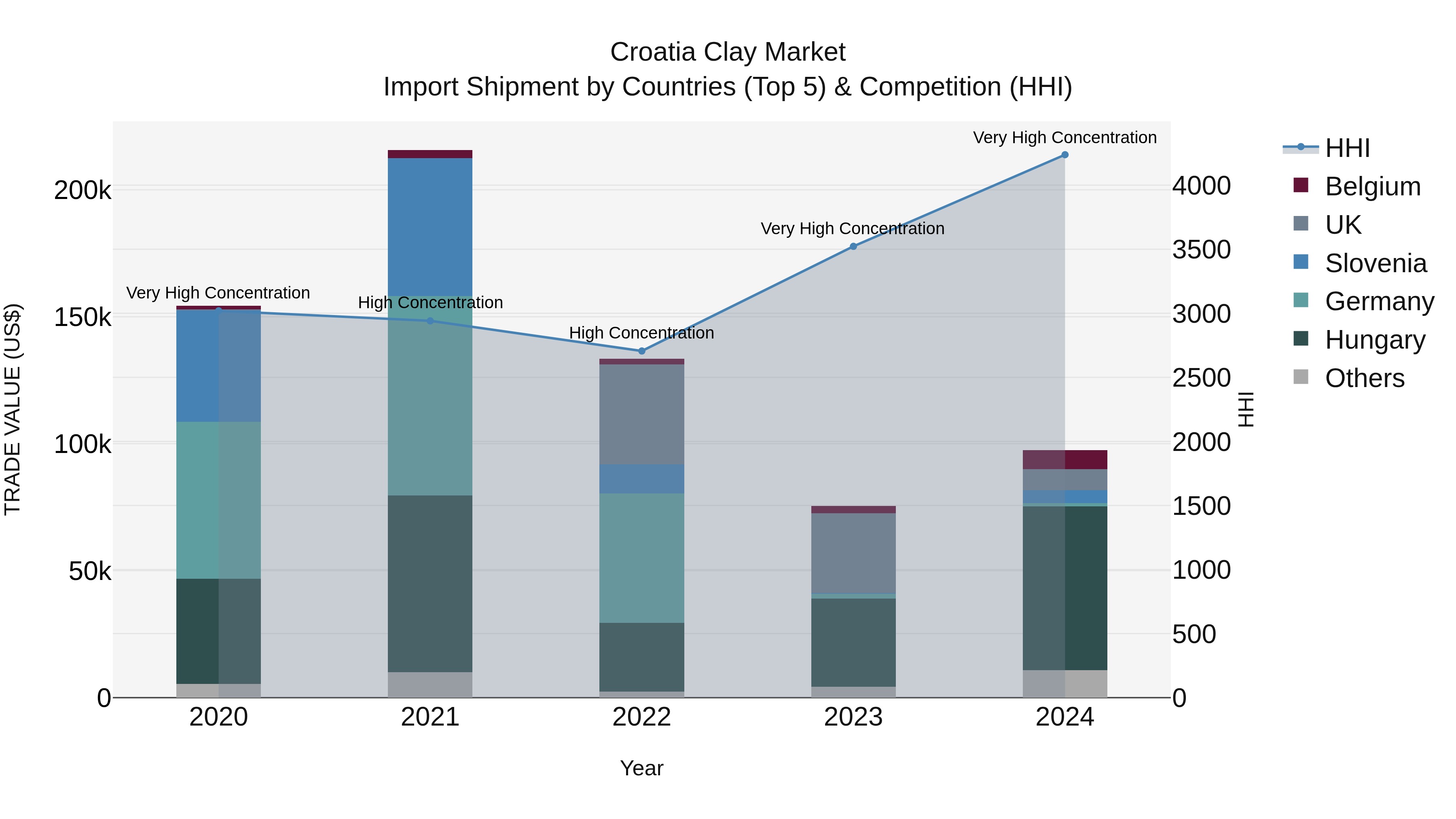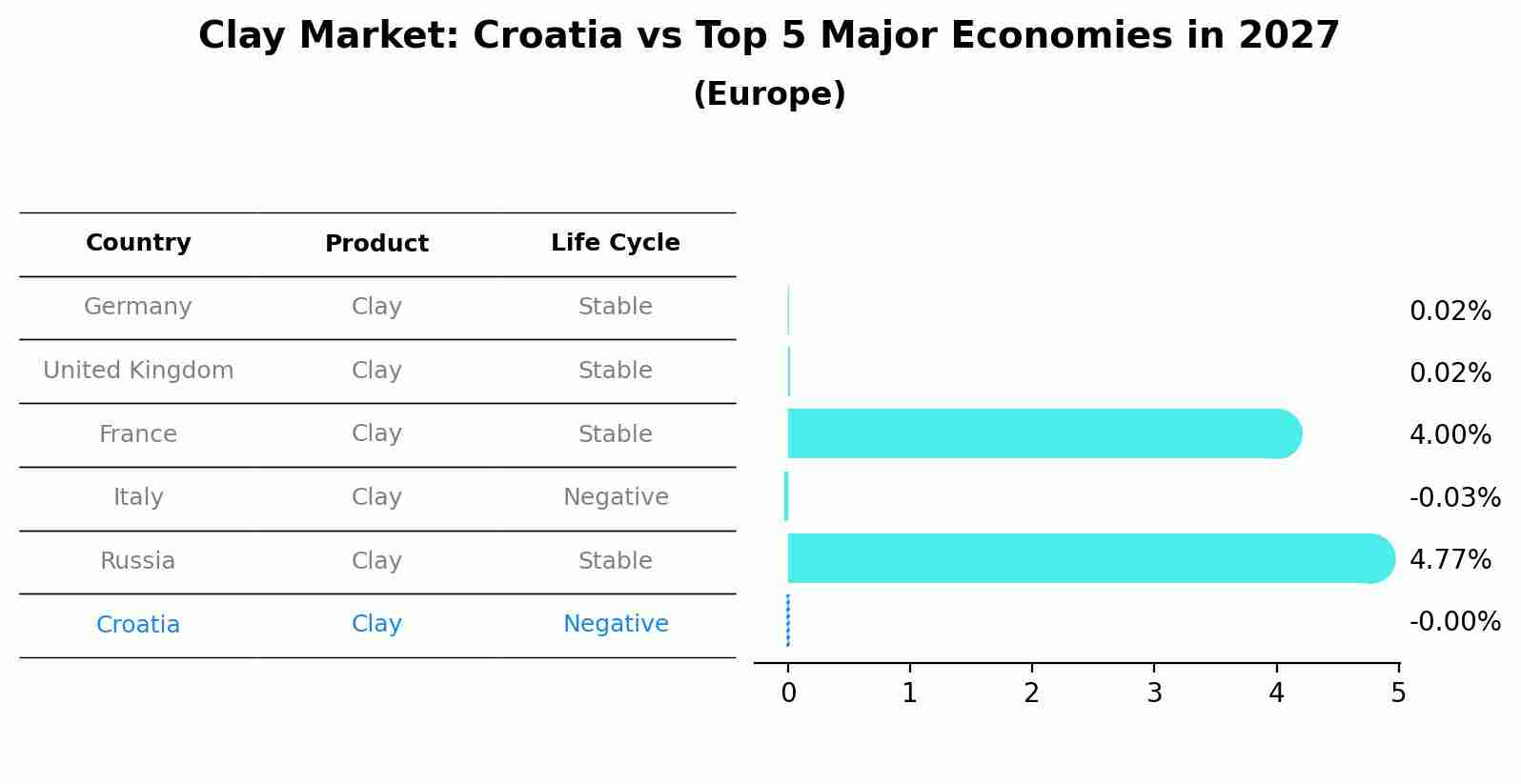Croatia Clay Market (2025-2031) | Segmentation, Analysis, Outlook, Industry, Forecast, Trends, Growth, Revenue, Companies, Share, Size & Value
| Product Code: ETC5257645 | Publication Date: Nov 2023 | Updated Date: Oct 2025 | Product Type: Market Research Report | |
| Publisher: 6Wresearch | Author: Bhawna Singh | No. of Pages: 60 | No. of Figures: 30 | No. of Tables: 5 |
Croatia Clay Market Top 5 Importing Countries and Market Competition (HHI) Analysis
Croatia clay import market in 2024 continued to be dominated by key players such as Hungary, Netherlands, UK, Belgium, and Slovenia. The high Herfindahl-Hirschman Index (HHI) indicates a concentrated market structure. Despite a negative compound annual growth rate (CAGR) from 2020 to 2024, the sector showed a significant growth rate of 29.13% from 2023 to 2024, suggesting a potential turnaround or emerging opportunities in the clay import industry in Croatia. Stakeholders should closely monitor these trends to capitalize on the evolving market dynamics.

Clay Market: Croatia vs Top 5 Major Economies in 2027 (Europe)
By 2027, Croatia's Clay market is forecasted to achieve a negative growth rate of -0.00%, with Germany leading the Europe region, followed by United Kingdom, France, Italy and Russia.

Croatia Clay Market Overview
The Class D audio amplifier market in Croatia is growing due to the rising demand for energy-efficient, high-quality sound systems in both consumer electronics and automotive sectors. The market is expected to continue its expansion as advancements in audio technology evolve.
Drivers of the market
The clay market in Croatia is influenced by its applications in ceramics, construction, and industrial processes. Clay is used for making pottery, tiles, and bricks, as well as in various manufacturing and environmental applications. The growth in construction and ceramics industries, along with innovations in clay-based materials, supports market demand.
Challenges of the market
The clay market in Croatia encounters challenges related to raw material sourcing and environmental regulations. Clay, used in ceramics, construction, and various industrial applications, relies on stable sources of high-quality raw materials. Additionally, the extraction and processing of clay must comply with environmental regulations concerning land use and waste management, increasing operational complexity. Managing raw material supply while adhering to environmental regulations and maintaining product quality are key challenges.
Government Policy of the market
The clay market in Croatia is regulated by policies related to mining and environmental protection. The government enforces EU standards for the extraction and use of clay, ensuring sustainable practices and minimizing environmental impact associated with clay mining and processing.
Key Highlights of the Report:
- Croatia Clay Market Outlook
- Market Size of Croatia Clay Market, 2024
- Forecast of Croatia Clay Market, 2031
- Historical Data and Forecast of Croatia Clay Revenues & Volume for the Period 2021-2031
- Croatia Clay Market Trend Evolution
- Croatia Clay Market Drivers and Challenges
- Croatia Clay Price Trends
- Croatia Clay Porter`s Five Forces
- Croatia Clay Industry Life Cycle
- Historical Data and Forecast of Croatia Clay Market Revenues & Volume By Application for the Period 2021-2031
- Historical Data and Forecast of Croatia Clay Market Revenues & Volume By Tableware for the Period 2021-2031
- Historical Data and Forecast of Croatia Clay Market Revenues & Volume By Sanitary ware for the Period 2021-2031
- Historical Data and Forecast of Croatia Clay Market Revenues & Volume By Medical applications for the Period 2021-2031
- Historical Data and Forecast of Croatia Clay Market Revenues & Volume By End Use for the Period 2021-2031
- Historical Data and Forecast of Croatia Clay Market Revenues & Volume By Ceramic and for the Period 2021-2031
- Historical Data and Forecast of Croatia Clay Market Revenues & Volume By Non-ceramic for the Period 2021-2031
- Croatia Clay Import Export Trade Statistics
- Market Opportunity Assessment By Application
- Market Opportunity Assessment By End Use
- Croatia Clay Top Companies Market Share
- Croatia Clay Competitive Benchmarking By Technical and Operational Parameters
- Croatia Clay Company Profiles
- Croatia Clay Key Strategic Recommendations
Frequently Asked Questions About the Market Study (FAQs):
1 Executive Summary |
2 Introduction |
2.1 Key Highlights of the Report |
2.2 Report Description |
2.3 Market Scope & Segmentation |
2.4 Research Methodology |
2.5 Assumptions |
3 Croatia Clay Market Overview |
3.1 Croatia Country Macro Economic Indicators |
3.2 Croatia Clay Market Revenues & Volume, 2021 & 2031F |
3.3 Croatia Clay Market - Industry Life Cycle |
3.4 Croatia Clay Market - Porter's Five Forces |
3.5 Croatia Clay Market Revenues & Volume Share, By Application, 2021 & 2031F |
3.6 Croatia Clay Market Revenues & Volume Share, By End Use, 2021 & 2031F |
4 Croatia Clay Market Dynamics |
4.1 Impact Analysis |
4.2 Market Drivers |
4.2.1 Growing demand for clay in construction and infrastructure projects in Croatia |
4.2.2 Increasing use of clay in pottery and ceramics industry |
4.2.3 Rising awareness about the sustainable and eco-friendly nature of clay products |
4.3 Market Restraints |
4.3.1 Fluctuating raw material prices impacting the cost of clay production |
4.3.2 Competition from alternative materials such as plastics and metals |
4.3.3 Regulatory challenges related to environmental impact and mining regulations |
5 Croatia Clay Market Trends |
6 Croatia Clay Market Segmentations |
6.1 Croatia Clay Market, By Application |
6.1.1 Overview and Analysis |
6.1.2 Croatia Clay Market Revenues & Volume, By Tableware, 2021-2031F |
6.1.3 Croatia Clay Market Revenues & Volume, By Sanitary ware, 2021-2031F |
6.1.4 Croatia Clay Market Revenues & Volume, By Medical applications, 2021-2031F |
6.2 Croatia Clay Market, By End Use |
6.2.1 Overview and Analysis |
6.2.2 Croatia Clay Market Revenues & Volume, By Ceramic and, 2021-2031F |
6.2.3 Croatia Clay Market Revenues & Volume, By Non-ceramic, 2021-2031F |
7 Croatia Clay Market Import-Export Trade Statistics |
7.1 Croatia Clay Market Export to Major Countries |
7.2 Croatia Clay Market Imports from Major Countries |
8 Croatia Clay Market Key Performance Indicators |
8.1 Percentage increase in the number of construction projects using clay as a primary material |
8.2 Average revenue per customer in the pottery and ceramics industry using clay |
8.3 Adoption rate of sustainable clay products in various sectors such as construction, packaging, and consumer goods |
9 Croatia Clay Market - Opportunity Assessment |
9.1 Croatia Clay Market Opportunity Assessment, By Application, 2021 & 2031F |
9.2 Croatia Clay Market Opportunity Assessment, By End Use, 2021 & 2031F |
10 Croatia Clay Market - Competitive Landscape |
10.1 Croatia Clay Market Revenue Share, By Companies, 2024 |
10.2 Croatia Clay Market Competitive Benchmarking, By Operating and Technical Parameters |
11 Company Profiles |
12 Recommendations | 13 Disclaimer |
- Single User License$ 1,995
- Department License$ 2,400
- Site License$ 3,120
- Global License$ 3,795
Search
Related Reports
- ASEAN and Thailand Brain Health Supplements Market (2025-2031) | Strategy, Consumer Insights, Analysis, Investment Trends, Opportunities, Growth, Size, Share, Industry, Revenue, Segments, Value, Segmentation, Supply, Forecast, Restraints, Outlook, Competition, Drivers, Trends, Demand, Pricing Analysis, Competitive, Strategic Insights, Companies, Challenges
- ASEAN Bearings Market (2025-2031) | Strategy, Consumer Insights, Analysis, Investment Trends, Opportunities, Growth, Size, Share, Industry, Revenue, Segments, Value, Segmentation, Supply, Forecast, Restraints, Outlook, Competition, Drivers, Trends, Demand, Pricing Analysis, Competitive, Strategic Insights, Companies, Challenges
- Europe Flooring Market (2025-2031) | Outlook, Share, Industry, Trends, Forecast, Companies, Revenue, Size, Analysis, Growth & Value
- Saudi Arabia Manlift Market (2025-2031) | Outlook, Size, Growth, Trends, Companies, Industry, Revenue, Value, Share, Forecast & Analysis
- Uganda Excavator, Crane, and Wheel Loaders Market (2025-2031) | Strategy, Consumer Insights, Analysis, Investment Trends, Opportunities, Growth, Size, Share, Industry, Revenue, Segments, Value, Segmentation, Supply, Forecast, Restraints, Outlook, Competition, Drivers, Trends, Demand, Pricing Analysis, Competitive, Strategic Insights, Companies, Challenges
- Rwanda Excavator, Crane, and Wheel Loaders Market (2025-2031) | Strategy, Consumer Insights, Analysis, Investment Trends, Opportunities, Growth, Size, Share, Industry, Revenue, Segments, Value, Segmentation, Supply, Forecast, Restraints, Outlook, Competition, Drivers, Trends, Demand, Pricing Analysis, Competitive, Strategic Insights, Companies, Challenges
- Kenya Excavator, Crane, and Wheel Loaders Market (2025-2031) | Strategy, Consumer Insights, Analysis, Investment Trends, Opportunities, Growth, Size, Share, Industry, Revenue, Segments, Value, Segmentation, Supply, Forecast, Restraints, Outlook, Competition, Drivers, Trends, Demand, Pricing Analysis, Competitive, Strategic Insights, Companies, Challenges
- Angola Excavator, Crane, and Wheel Loaders Market (2025-2031) | Strategy, Consumer Insights, Analysis, Investment Trends, Opportunities, Growth, Size, Share, Industry, Revenue, Segments, Value, Segmentation, Supply, Forecast, Restraints, Outlook, Competition, Drivers, Trends, Demand, Pricing Analysis, Competitive, Strategic Insights, Companies, Challenges
- Israel Intelligent Transport System Market (2025-2031) | Strategy, Consumer Insights, Analysis, Investment Trends, Opportunities, Growth, Size, Share, Industry, Revenue, Segments, Value, Segmentation, Supply, Forecast, Restraints, Outlook, Competition, Drivers, Trends, Demand, Pricing Analysis, Competitive, Strategic Insights, Companies, Challenges
- Uganda Precast and Aggregate Market (2025-2031) | Strategy, Consumer Insights, Analysis, Investment Trends, Opportunities, Growth, Size, Share, Industry, Revenue, Segments, Value, Segmentation, Supply, Forecast, Restraints, Outlook, Competition, Drivers, Trends, Demand, Pricing Analysis, Competitive, Strategic Insights, Companies, Challenges
Industry Events and Analyst Meet
Our Clients
Whitepaper
- Middle East & Africa Commercial Security Market Click here to view more.
- Middle East & Africa Fire Safety Systems & Equipment Market Click here to view more.
- GCC Drone Market Click here to view more.
- Middle East Lighting Fixture Market Click here to view more.
- GCC Physical & Perimeter Security Market Click here to view more.
6WResearch In News
- Doha a strategic location for EV manufacturing hub: IPA Qatar
- Demand for luxury TVs surging in the GCC, says Samsung
- Empowering Growth: The Thriving Journey of Bangladesh’s Cable Industry
- Demand for luxury TVs surging in the GCC, says Samsung
- Video call with a traditional healer? Once unthinkable, it’s now common in South Africa
- Intelligent Buildings To Smooth GCC’s Path To Net Zero













